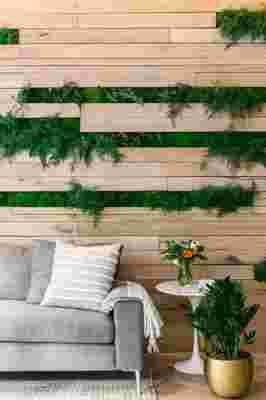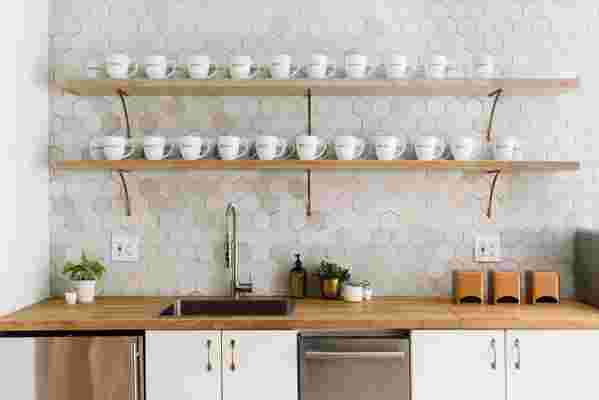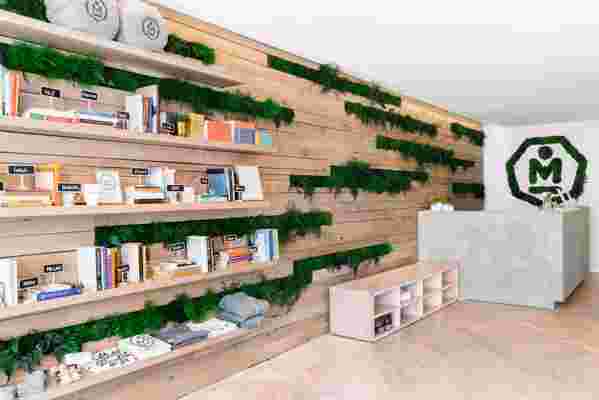When you picture a meditation studio, a stark white—and silent— ashram might come to mind. If you're thinking Eat, Pray, Love, you might also have the notion that lost souls descend on a studio to experience a (quiet) emotional breakdown or life-altering breakthrough. At MNDFL's Greenwich Village New York flagship and new Upper East Side location, everything you think you knew about the practice is upended. Though meditation may seem like a solitary activity, MNDFL creates a communal and welcoming space for students to gather, read, talk, and just relax. In conjunction with interior decorating company Homepolish and plant design firms the The Sill and Artisan Moss , the brand has conjured a surprisingly warm and decidedly un-studio-like environment. Herringbone floors, neutral and natural elements, and a coat of Benjamin Moore's aptly named Calm white paint complete the look. You feel totally comfortable turning of your cell phone, kicking off your shoes (both are required), and settling in a for a quiet read on a spacious gray couch (not required, but encouraged) with a complimentary cup of turmeric ginger tea. One design element has become the brand's signature: a living wall. In MNDFL's first studio, located on Eighth Street, the large vertical garden became an Instagram phenomenon. But it's not just for show—the beautiful greenery also has some unexpected benefits. Read on to learn how indoor plants can improve your meditation practice—and your health.

A quiet corner to contemplate before or after a class.
They Promote Deep Breathing MNDFL CEO Ellie Burrows first hatched the idea for a living wall while in Mexico. She stumbled on a building whose entire façade had been irrigated and laced with greenery and immediately gasped at its beauty. "I saw [the vertical garden] and in awe, took a giant breath," she says. "The beauty of the wall instantly connected me to my breath, and I wanted to re-create that on a smaller scale at MNDFL. I've seen similar reactions in the studio when people see our greenery for the first time." For a place that's focusing on breathing patterns, it seemed like kismet.

In the kitchen area, anyone can enjoy a cup of tea and beautiful hexagonal tile.
They Keep It Quiet Wood is a prominent theme in both MNDFL studios. In fact, the Upper East Side location has a slatted wall punctuated by moss and ferns that serves the dual purpose of absorbing and muting outside noise before it reaches the studio. "We wanted to include natural and unobtrusive elements," Burrows says. "In fact, we use all the elements: wood in the floors and walls, earth via plants, metal in the light fixtures, water in our tea, and fire with our candles."

The slatted wall is just as beautiful as it is functional.
They Bring the Outdoors In One obvious benefit of indoor plants is that they provide a glimpse of the great outdoors—much needed for New Yorkers. Even better, they literally make the indoor air more fresh. "Plants make a room happier! They are a nice reminder of the natural world and can really brighten someone's day in this concrete jungle—and in the dead of winter," says Burrows. According to Artisan Moss, "Plants absorb carbon dioxide, release oxygen, create humidity, and naturally filter indoor air of harmful toxins." No seasonal affective disorder here.
A large, comfortable couch, rattan poufs, and other seating options abound in MNDFL's Upper East Side studio.
They're Relaxing Plants don't just improve the aesthetic or oxygen flow in any given room; they also have proven health benefits. "Plants give us a lot, and they don't expect much (aside from some light and water) in return," says The Sill. "They have been shown to boost our moods and increase our focus, productivity, and creativity. They can reduce the stress of our daily lives and give us a sense of calmness and harmony with nature." Consider a stop to smell the roses next time you're feeling a bit down.
This content can also be viewed on the site it originates from.
Now that you're convinced of the benefits of a vertical garden (or even just more potted plants), how to choose the best type? Artisan Moss says look to the light. "First and foremost, we based our choices off the space's natural light conditions. Because of its lack of bright sunlight, we chose plants that thrive in moderate to lower light conditions." Moss and ferns, treated with a light, vegetable-based food preservative to ensure there was no upkeep required, fit the bill, along with mini-succulents for accents. Now all that's left to do is grab a cushion and breathe in.